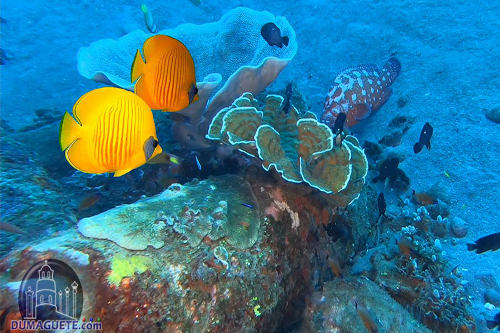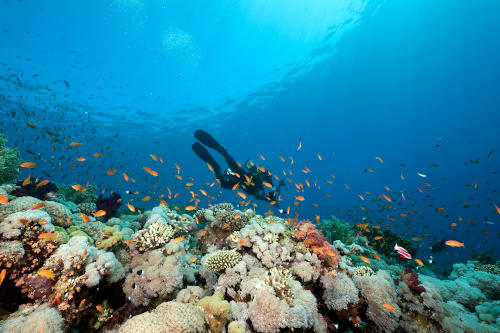The Best Diving in the Philippines
The Philippines is an excellent destination to fit any diver’s needs. The Pacific waters have it all: dive sites fit for new and advanced divers, great sights for macro and wide-angle photographers, and anything from wreck diving to blackwater diving. Not only that, but the land is stunning with white sandy beaches and dense jungles. Here are some of the top destinations in the Philippines for divers.
Malapascua Island, Cebu

Malapascua Island is a small island located just north of Cebu’s mainland. Malapascua’s waters are unique as they are the only waters where thresher sharks roam daily. The sea is part of a marine park and divers are able to watch the sharks be cleaned by the schools of fish. The sharks lurk in the early morning to avoid direct sunlight, so divers often start their day before the sun rises. As divers travel to the Monad Shoal, they will get to watch the sunrise over the calm waters. The island is also home to plenty of macro marine life such as nudibranchs, seahorses, scorpionfish, and more that are perfect for macro photography. Photo courtesy of Hugh Ross.
Dauin, Dumaguete

Located in the province of Negros Oriental, Dauin is ideal for photographers and lovers of macro life. Underwater creatures often seen include seahorses, pipefish, nudibranchs, blue-ring octopuses, mandarin fish, and more. Not only that, but there is a unique collection of experiences that will be sure to excite any visitor such as muck diving and pristine coral reefs. Diving in Dauin is great all year long with the dry season lasting from December to May and the wet season lasting from June to November. Dauin is famous for its often cheap, always luxurious beachfront resorts. Photo courtesy of Dumaguete.com
Puerto Galera

As a vibrant town with diverse waters, Puerto Galera is perfect for any level of diver. The diving experience can vary greatly — ranging from canyons to wrecks to muck diving and just about everything in between. The location is also perfect for macro and wide-angle photographers alike due to the coral reefs’ rich biodiversity. Some of the reefs are even considered to have the most biodiversity in all of Asia. The town is also home to plenty of dive schools that are perfect for beginnings and advanced divers looking to expand their skills. Guests have just as much to explore on land as they do in the water as there are stunning mountains and waterfalls to explore. Guests are often able to see creatures such as nudibranchs, frogfish, seahorses, cardinalfish, and more. Photo courtesy of Asia Divers.
Subic Bay, Luzon

Nestled just about 100 kilometers away from Manila Bay is Subic Bay on Luzon Island. The bay has a history of serving as one of the largest US Naval Bases in Asia and is thus home to more than 20 interesting shipwrecks. These wrecks are unique due to the volcano Mount Pinatubo that has coated the wrecks in ash. The USS New York is perhaps one of the most well-known wrecks in Subic Bay due to its pristine condition and canons. The ship is only available to explore during select times due to its proximity to the pier. For technical divers and divers experienced in deep water diving, the F-4 Phantom wreck is a dream. At 45 meters deep, the plane is often teeming with fish in the calm waters. Diving in the bay is great all year round but is ideal during the November to May dry season for greatest visibility. Photo courtesy of Arizona Dive Shop, Philippines.
Tubbataha Reef
World Heritage Site

With the most biodiversity in Asia, divers can encounter 600 species of fish and 360 species of coral in the Tubbataha Reefs Natural Park. Tubbataha is the largest marine park in the Philippines at 970 square kilometers. Guests can only experience the lively waters on a liveaboard during the calmer months of March to June. Diving experiences often include wall diving as well as exploration of the two atolls, Jessie Beazley Reef, lagoons, and coral cays. Perhaps the most exciting experience from exploring the park is the chance to see large marine life such as whale sharks, tiger sharks, and manta rays. Photo courtesy of Philippine Tourism USA.
Anilao, Batangas

Famous for its muck diving and blackwater diving, Anilao is an ideal destination for those looking to get up close and personal with the smallest of critters. Macro photographers will love swimming through the pinnacles, walls, and coral gardens to get the perfect shot. Some of the critters include elusive subjects such as the Ambon scorpionfish, Bobbit worms, and stargazers. The best time to dive in Anilao is from October to June, and April and May are considered to be the peak of the season. However, diving is available all year long with colder temperatures from December to March and rainier weather from July to September. The location is extremely convenient as it is just two hours away from Manila and has access to all of the dive sites from Balayan Bay, Batangas Bay, and Maricaban Island. Photo courtesy of Mike Batrick / Crystal Blue Resort.
Bohol, Central Visayas

Located in the Central Visayas region, Bohol is an island most well-known for its coral reefs and the unique Chocolate Hills. The Chocolate Hills are perfectly rounded hills that turn brown during the summer, leaving them to look like drops of chocolate amongst the dense green jungle. However, the land isn’t the only distinct quality of the island as it is also known for some of the best diving in the world. Divers can find both hard and soft coral along the stunning coral reefs or find large marine life such as the blacktip shark. Certain dive sites, such as those found off of the nearby Balicasag Island’s shore, are perfect for more advanced divers. There are strong currents with steep walls and even hammerhead sharks from December to January. Although Bohol itself is a popular tourist destination, Anda is the perfect spot for visitors who want to experience the amazing Bohol dive sites and be set away from busy tourist life. Diving in Bohol can be done all year long but is best from January to May. Photo courtesy of Dive-Bohol.com.